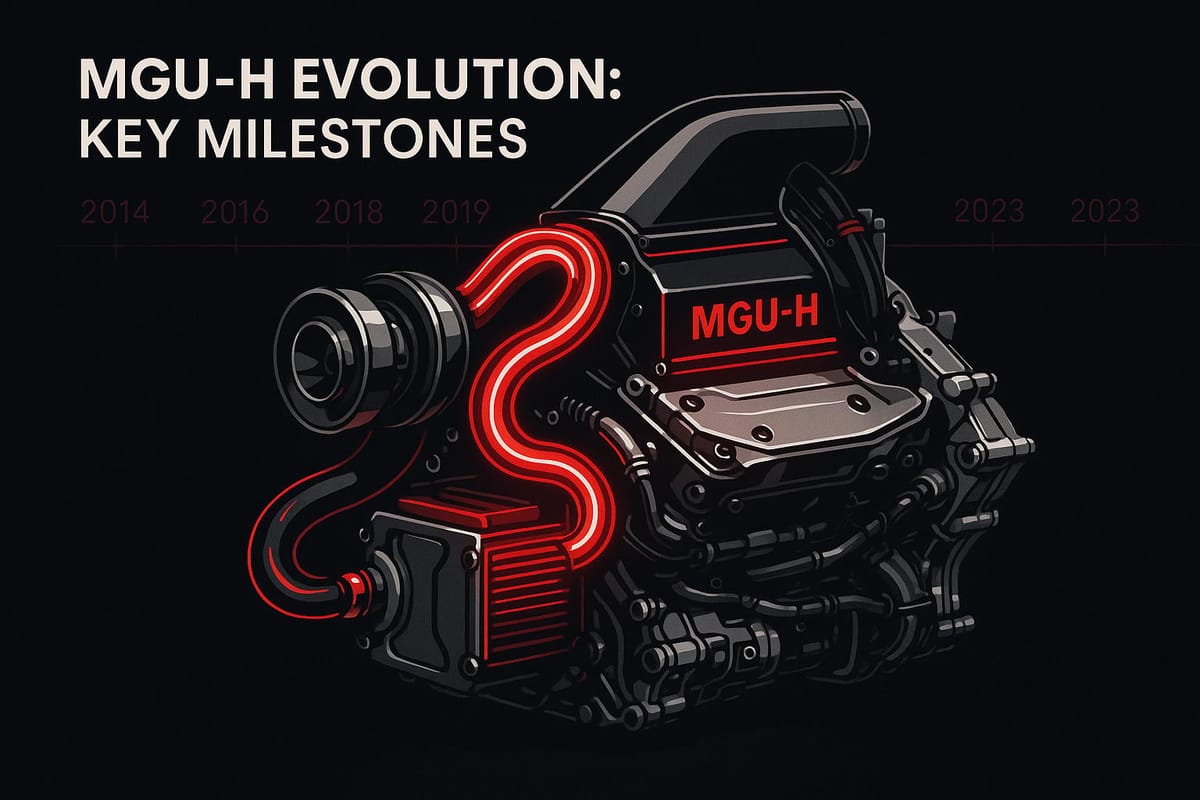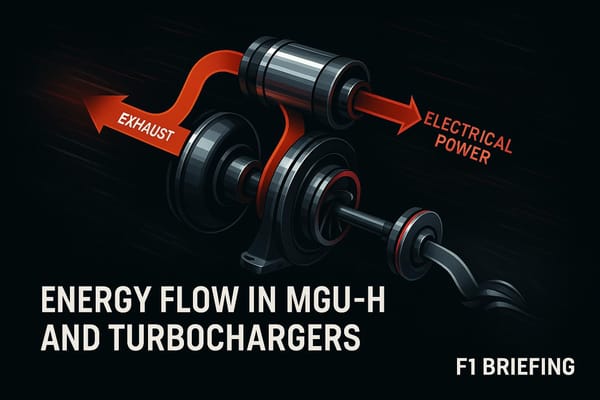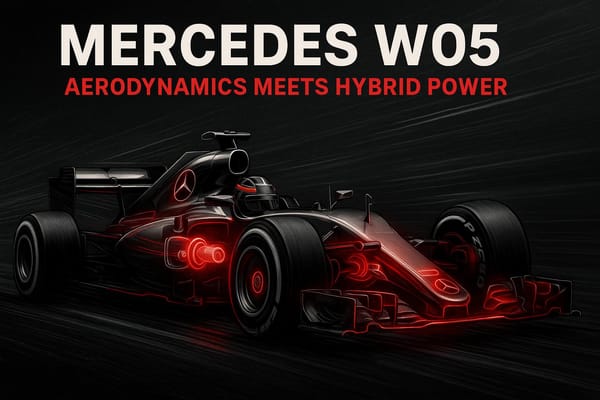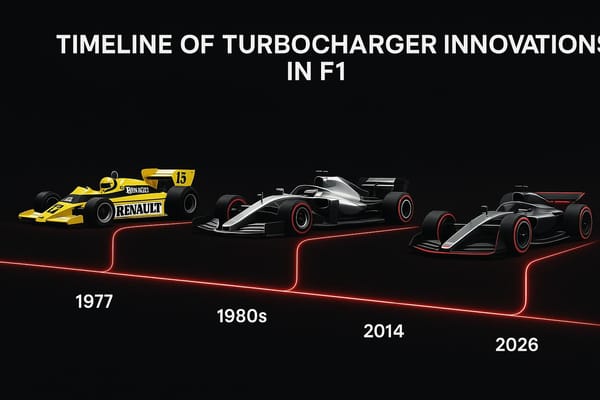MGU-H Evolution: Key Milestones
Explore the evolution and impact of the MGU-H in Formula 1, from its groundbreaking introduction to its upcoming retirement in 2026.

The MGU-H, or Motor Generator Unit – Heat, has been a cornerstone of Formula 1's hybrid power units since its introduction in 2014. This advanced system converts heat from exhaust gases into electrical energy, boosting performance and efficiency. Positioned on the turbocharger shaft, it also helps eliminate turbo lag by driving the turbocharger when needed. Over the years, it has added up to 50 horsepower and pushed thermal efficiency beyond 50%, making it a game-changer in motorsport engineering.
However, the MGU-H was not without challenges. Its complexity and high costs led to reliability issues, especially in its early years. Mercedes dominated the field by mastering integration, while other teams like Renault and Ferrari struggled to keep pace. Despite its technical benefits, the MGU-H will be retired after the 2025 season due to regulatory changes aimed at simplifying power unit design and reducing costs. Starting in 2026, Formula 1 will rely solely on the MGU-K for hybrid power, alongside the adoption of 100% sustainable fuels.
The MGU-H's legacy extends beyond racing. Its technology has already made its way into road cars, with systems like Mercedes-AMG's "electric exhaust gas turbocharger" eliminating turbo lag and improving efficiency. While the MGU-H era in Formula 1 is ending, its impact on engineering and automotive innovation will endure.
Why Is F1 MGU-H Integration So Difficult? - Pole Position Experts
2014: The Start of the MGU-H Era
The 2014 Formula One season marked a groundbreaking moment in motorsport. The FIA introduced 1.6-liter V6 turbo-hybrid power units, replacing the naturally aspirated V8 engines that had been the standard. This shift aimed to prioritize fuel efficiency and align with global trends, while still delivering the high-performance racing fans craved.
These new regulations also brought F1 closer to road car technology by imposing fuel flow limits, pushing teams to innovate in hybrid systems. At the heart of this transformation was the MGU-H, a key component that would soon become a defining feature of the hybrid era.
Only three manufacturers - Mercedes, Ferrari, and Renault - took on the challenge of developing these complex power units. From the outset, Mercedes surged ahead, thanks to their superior engineering and integration.
How MGU-H Works
The MGU-H (Motor Generator Unit - Heat) operates in two key ways. Under full throttle, it captures energy from exhaust gases, converting wasted heat into usable power. When the driver lifts off the throttle, the MGU-H acts as a motor, spinning the turbocharger to eliminate turbo lag. This dual functionality gave teams a significant advantage in 2014, ensuring smoother and more consistent power delivery throughout a lap.
In terms of output, the 2014 power units generated around 600 horsepower from the internal combustion engine, with an additional 160 horsepower coming from the hybrid systems. The MGU-H played a pivotal role in this hybrid boost. Notably, the FIA placed few restrictions on the MGU-H's energy and power output, giving manufacturers room to push the boundaries of performance and innovation.
First Year Problems and Team Solutions
Despite its promise, the MGU-H presented significant challenges in its debut year. Reliability issues, system complexity, and high integration costs plagued teams. Common problems included overheating, electrical malfunctions, and bearing failures, which sometimes left drivers stranded mid-race.
Mercedes quickly gained an edge by prioritizing a robust design and seamless integration of the MGU-H. While other teams like Renault and Ferrari grappled with frequent breakdowns, Mercedes delivered reliable systems that maximized energy recovery and performance.
| Manufacturer | 2014 MGU-H Performance | Reliability | Competitive Impact |
|---|---|---|---|
| Mercedes | High | High | Dominated early hybrid era |
| Ferrari | Moderate | Moderate | Competitive but lagged behind |
| Renault | Low | Low | Struggled with frequent failures |
The financial burden was immense. By the mid-2010s, a full F1 power unit, including the MGU-H, cost customer teams over $10 million per season. This added pressure to resolve technical issues quickly. Teams that adapted found creative solutions: Honda, joining in 2015, improved bearing designs and compressor efficiency, while Mercedes continued refining their integration strategies.
The 2014 season proved that the MGU-H wasn’t just a technical add-on - it was a revolutionary piece of technology. It rewarded engineering brilliance and forced teams to master its complexities to stay competitive.
MGU-H Development from 2015 to 2025
The years following 2014 marked a period of significant refinement in MGU-H technology, as manufacturers worked to resolve early reliability issues and improve power delivery in Formula 1 engines. These advancements laid the groundwork for unique approaches by different manufacturers in the seasons that followed.
Key Manufacturer Advances
Mercedes emerged as a leader in MGU-H integration, thanks to its innovative design. The team placed the MGU-H between the compressor and turbine within the turbocharger assembly, positioning the entire unit in the center of the vee of its 1.6-liter V6 engine. This setup allowed for seamless energy conversion, with the MGU-H closely integrated into the turbocharger. By 2015, Mercedes' design delivered an impressive 870 horsepower, making their engine the most powerful that season. Their system worked both ways - harvesting energy from exhaust gases during recovery phases and eliminating turbo lag by spinning the turbocharger when exhaust energy was insufficient.
Honda returned to Formula 1 in 2015 and focused on refining the MGU-H for better performance. Their engineers prioritized thermal efficiency and improved both the pressure ratio and airflow. A major step forward came in 2018 with the RA618H power unit, which introduced a revised bearing support structure. This change extended the shaft and resolved bearing-related reliability issues. By 2021, Honda further enhanced its design by increasing the rigidity of the MGU-K housing, allowing it to handle the vibrations caused by higher combustion pressures.
Ferrari and Renault took alternative paths in their development. While Ferrari's technical details remain undisclosed, Renault demonstrated its focus on peak power output. By 2019, their engine reportedly achieved 1,000 horsepower in qualifying trim, showcasing the impact of advanced MGU-H integration.
Performance Gains from MGU-H
Between 2015 and 2019, the MGU-H contributed significantly to engine performance, with manufacturers adding approximately 30–50 horsepower compared to 2014 levels. Unlike the MGU-K, which has a 2-megajoule energy recovery limit, the MGU-H can recover unlimited energy from exhaust gases. This capability made it essential for improving overall power unit efficiency. Teams leveraged the MGU-H to strategically manage energy, either transferring it directly to the MGU-K for an immediate power boost or storing it in the battery for later use.
| Year | Key Performance Milestone | Leading Manufacturer |
|---|---|---|
| 2015 | 870 hp peak power achieved | Mercedes |
| 2018 | Bearing reliability breakthrough | Honda |
| 2019 | 1,000 hp in qualifying trim | Renault |
Rule Changes and Development Impact
As teams mastered MGU-H technology, the regulatory landscape evolved to shape its development. The FIA imposed minimal restrictions on the MGU-H, requiring only a minimum weight of four kilograms. This allowed teams to maximize energy recovery and output from the system.
In January 2018, the FIA introduced a directive to ensure that engine manufacturers provided equal power units to customer teams. This rule aimed to maintain performance parity between works and customer teams while still allowing manufacturers to innovate.
The most transformative change came in 2022, with the introduction of a power unit design freeze. Starting March 1, 2022, the internal combustion engine, turbocharger, and MGU-H were frozen, while the energy store, MGU-K, and control electronics were frozen on September 1, 2022. This freeze, which will remain in place until 2026, effectively halted further MGU-H development. The decision was partly driven by the lack of new engine supplier entries in 2021–2022 and postponed earlier plans to remove the MGU-H by 2021.
Interestingly, these regulatory changes also influenced the adoption of MGU-H technology in road cars, highlighting its potential benefits beyond the racetrack.
2026: The End of MGU-H
After more than a decade of development, Formula 1 is moving into a new chapter. Starting in 2026, F1 power units will no longer include the MGU-H. This marks the end of a hybrid component that, while technically advanced, proved too complex and expensive to sustain in the long run.
Why MGU-H is Being Removed
The MGU-H's design has always been a double-edged sword. On one hand, it showcased impressive engineering. On the other, its complexity and high costs discouraged new manufacturers from entering the sport. Developing and maintaining the system required a level of expertise and financial commitment that many potential suppliers simply couldn’t justify. For instance, Cosworth - a name synonymous with F1 engine history - chose not to participate in the hybrid era due to these challenges.
Even for established manufacturers, the MGU-H posed a financial strain. The ongoing development costs created an uneven playing field, as not all manufacturers could keep up. In response, regulators froze MGU-H development, highlighting the system's technical and financial hurdles and the lack of new entrants willing to take on such a demanding component.
These factors made it clear that change was necessary, paving the way for a simpler, more inclusive design for 2026.
New 2026 Power Unit Rules
The lessons learned over the past decade have shaped the new regulations. The 2026 power units aim to simplify design while staying true to Formula 1's hybrid roots and commitment to sustainable technology. The MGU-H will be retired, leaving the MGU-K as the sole hybrid system. At the same time, the sport will shift to 100% sustainable fuels.
Under these new rules, hybrid power will play a much larger role, contributing up to 50% of the total output compared to the previous ~30%. This increase will be achieved by improving the MGU-K, eliminating the need for the more intricate MGU-H. The focus will also shift from recovering heat energy to maximizing fuel efficiency and environmental responsibility.
| Component | 2014–2025 Era | 2026+ Era |
|---|---|---|
| Hybrid Systems | MGU-K + MGU-H | MGU-K only |
| Fuel Type | Traditional racing fuel | 100% sustainable fuels |
| Hybrid Power Contribution | ~30% of total output | Up to 50% of total output |
| Development Complexity | Very high | Reduced |
| Manufacturer Entry Barriers | Significant | Lowered |
With the MGU-H gone, manufacturers will need to tackle new engineering challenges, such as managing turbo lag without the instant response it provided. This will likely lead to innovations in turbocharger design, energy management, and battery technology to offset the loss.
The streamlined regulations aim to cut costs and make it easier for new engine suppliers to join the competition. By reducing the technological gap between manufacturers, the changes are designed to promote closer racing while still encouraging advancements in areas like energy recovery, battery performance, and sustainable fuel use.
Additionally, the introduction of standardized components will help control costs and reduce complexity. This will allow manufacturers to focus on performance innovations rather than pouring resources into expensive proprietary systems. The new approach reflects a shift from prioritizing technical extremes to fostering competitive racing and broader participation across the grid.
MGU-H's Lasting Impact
Even as the MGU-H nears its exit from Formula 1, its influence on motorsport and automotive engineering is undeniable. This technology pushed hybrid systems to new heights, sparking advancements that go beyond the racetrack and into everyday driving.
What F1 Learned from MGU-H
Over its decade in Formula 1, the MGU-H reshaped how hybrid systems are designed and managed. Teams refined energy recovery and deployment strategies while mastering the integration of thermal and electrical systems under the intense demands of racing conditions.
One of the standout achievements was achieving brake thermal efficiencies exceeding 50% by converting exhaust heat into electrical energy. This level of efficiency is extremely rare in traditional automotive engineering, showcasing the cutting-edge nature of F1's hybrid technologies.
The MGU-H also drove the development of compact, highly integrated power units. Engineers tackled complex challenges like turbo lag, durability, and seamless power delivery between combustion engines and hybrid components. These efforts led to advancements in simulation tools, control software, and reliability engineering.
F1’s regulatory environment played a role, too. While the MGU-H had a minimum weight requirement of four kilograms, there were no limits on its energy or power output. This flexibility encouraged teams to devise innovative solutions, balancing performance and reliability over demanding race distances.
Throughout its evolution, the MGU-H delivered noticeable horsepower gains, cementing its place as a cornerstone of F1's hybrid era.
MGU-H Technology in Road Cars
The MGU-H’s influence isn’t confined to the track - it’s already making its way into consumer vehicles. Mercedes-AMG has taken the lead in adapting this F1 technology for road use. In May 2021, the company announced plans to incorporate MGU-H-derived systems into future AMG models, developed in collaboration with Garrett Motion.
This adaptation, called an "electric exhaust gas turbocharger", works similarly to the MGU-H. A small electric motor powers the turbocharger’s compressor wheel before exhaust gases arrive, eliminating turbo lag and enhancing low-end torque. It marks the first direct application of MGU-H technology in consumer cars, with models expected as early as 2022–2023.
The table below highlights how the F1 MGU-H and its road car counterpart differ in purpose and functionality:
| Application | F1 MGU-H System | Mercedes-AMG Road Car Adaptation |
|---|---|---|
| Primary Purpose | Recover exhaust heat energy | Eliminate turbo lag, boost efficiency |
| Energy Management | Battery storage or direct use | Immediate turbo response |
| Performance Impact | Higher thermal efficiency | Increased low-end torque, efficiency |
| Regulatory Environment | Minimum weight, open output limits | Consumer safety, emissions standards |
This technology transfer is a clear example of how motorsport innovation benefits everyday drivers. While the F1 version focused on capturing exhaust energy for storage or immediate use, the road car version prioritizes instant turbo response and better efficiency.
Collaboration between F1 teams and automotive manufacturers has been key to this transition. Partnerships, technical publications, and engineering events have ensured that the knowledge gained from MGU-H development continues to shape the future of automotive technology, even as the MGU-H leaves the F1 grid.
Conclusion: MGU-H's Place in F1 History
Over the past decade, Formula 1 has seen an era of rapid innovation and evolving regulations, and the MGU-H stands out as a pivotal chapter in this story. Introduced in 2014 and set to be retired in 2026, this advanced system reshaped how F1 power units operate and pushed hybrid technology to new limits in motorsport.
From the outset, the MGU-H delivered notable performance improvements, solidifying its role in F1's hybrid evolution. Its ability to recover and repurpose energy set an entirely new standard for efficiency in the sport.
However, the system's complexity and high costs eventually led to a regulatory shift, steering the future of hybrid designs in a different direction.
The influence of the MGU-H extends far beyond the racetrack. For instance, Mercedes-AMG is preparing to roll out an electric exhaust gas turbocharger for road cars, directly inspired by this F1 technology. This is a prime example of how cutting-edge racing innovations can trickle down into everyday vehicles, blending performance with practicality.
As Formula 1 gears up for simpler hybrid systems starting in 2026, the MGU-H's legacy remains undeniable. It proved that energy recovery systems could deliver impressive performance gains while significantly advancing thermal efficiency. The knowledge gained - whether in overcoming integration challenges or improving reliability - will continue to shape motorsport and automotive engineering alike.
The MGU-H era will be remembered as a time when Formula 1 embraced bold technical ambitions, achieving remarkable progress while offering crucial insights into balancing innovation with real-world feasibility.
FAQs
Why is Formula 1 phasing out the MGU-H after the 2025 season?
The MGU-H (Motor Generator Unit – Heat) is set to bid farewell to Formula 1 after the 2025 season. This decision is part of the sport's efforts to move toward a future that's both more cost-efficient and environmentally conscious. The MGU-H, which captures energy from exhaust heat, has been a standout feature of hybrid power units. However, its intricate design and high development and maintenance costs have made it a challenging component.
By phasing out the MGU-H, Formula 1 aims to simplify engine designs, cut expenses, and encourage new engine manufacturers to join the grid. This shift ties into the sport's larger mission to achieve carbon neutrality, boost competition, and continue pushing the boundaries of high-performance engineering.
What role has the MGU-H played in improving the performance and efficiency of Formula 1 engines?
The MGU-H (Motor Generator Unit-Heat) plays a key role in improving the performance and efficiency of Formula 1 power units. Its function is to capture energy from exhaust gases and convert it into electrical energy. This energy can then be stored in the battery or sent directly to the MGU-K, giving the car an extra performance boost.
By enhancing energy recovery and cutting down on fuel usage, the MGU-H has allowed teams to achieve better thermal efficiency without compromising on speed. Its introduction marked an important milestone in hybrid technology for Formula 1, combining sustainability with top-tier performance.
How will removing the MGU-H affect the future of Formula 1 and automotive technology?
The decision to remove the MGU-H (Motor Generator Unit-Heat) is set to have a noticeable impact on both Formula 1 and the automotive industry. In Formula 1, this change simplifies the design of power units, which could lower costs and make it easier for new manufacturers to join the sport. On the flip side, teams will lose a critical component that has played a big role in energy recovery and improving efficiency.
For the automotive sector, the absence of the MGU-H in F1 might steer attention toward alternative energy recovery methods, like advanced battery systems or hybrid technologies. While the MGU-H has been a driver of progress in managing thermal energy, its removal could open the door for fresh developments in sustainable mobility and electrification approaches.




